HBC radiomatic P10004 Crane Remote Control Transmitter User Manual BE PATROL I V2 1
HBC-radiomatic GmbH Crane Remote Control Transmitter BE PATROL I V2 1
Contents
- 1. users manaul
- 2. 1521 statement page
users manaul
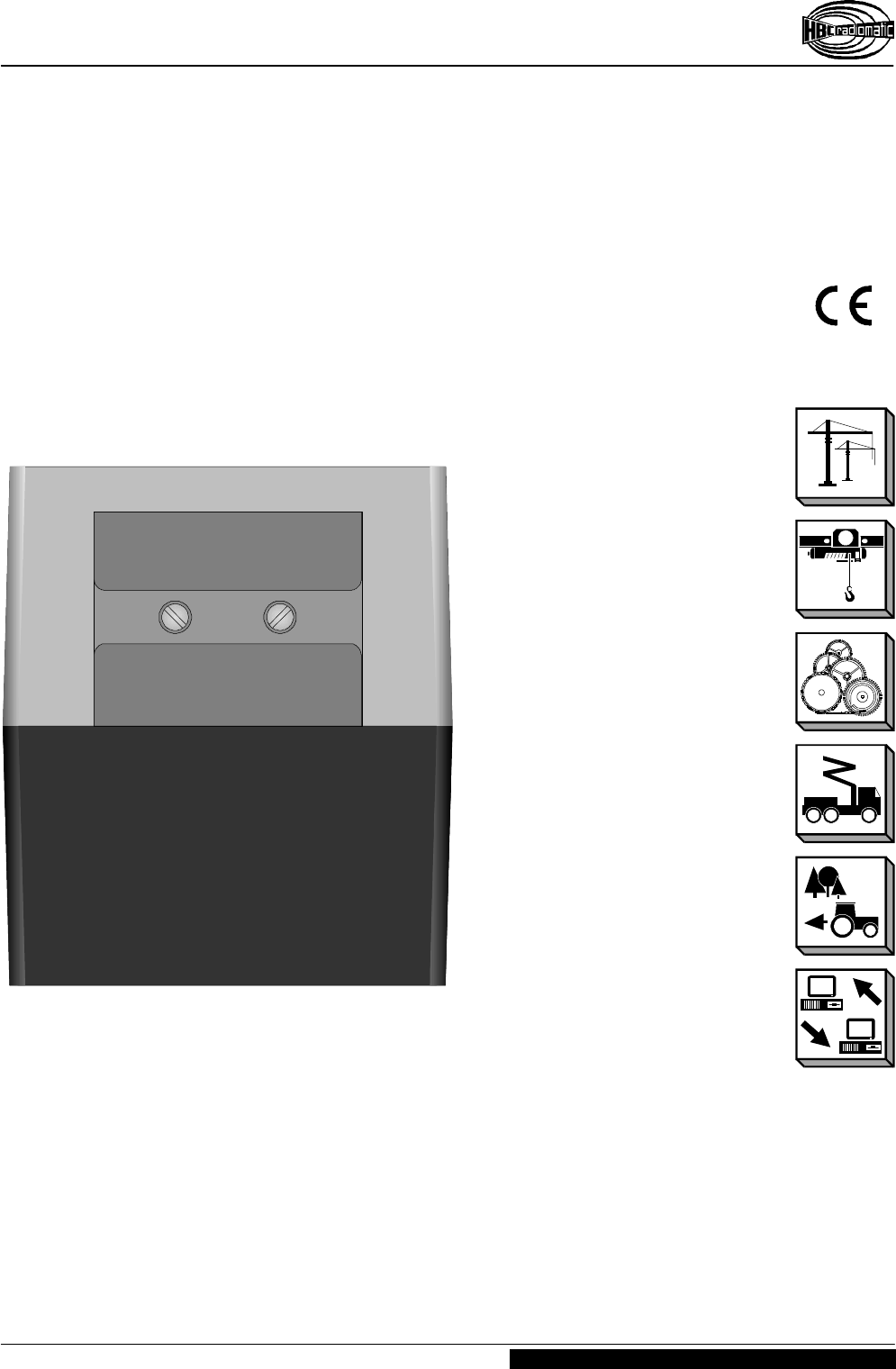
Operating Instructions
Radio Transmitter patrol ( Industrial Version )
BE-PATROL-I-V2-1.DOC [ Word 97 ] FL Page 1 / 14
HBC-radiomatic GmbH • D-74564 Crailsheim • GERMANY
All rights reserved through HBC-radiomatic GmbH. Technical changes made without notice. 04-25-2000
Radio Control System
HBC – Radio Controls
R
Ra
ad
di
io
o
T
Tr
ra
an
ns
sm
mi
it
tt
te
er
r
p
pa
at
tr
ro
ol
l
Industrial Version

Operating Instructions
Radio Transmitter patrol ( Industrial Version )
Page 2 / 14 BE-PATROL-I-V2-1.DOC [ Word 97 ] FL
HBC-radiomatic GmbH • D-74564 Crailsheim • GERMANY
04-25-2000 All rights reserved through HBC-radiomatic GmbH. Technical changes made without notice.
Radio Control System
Before proceeding with the installation, operation or maintenance of the radio control
equipment it is important that the installation, operating, and maintenance personnel
read this bulletin carefully in order to ensure the safe and efficient use of the machine.
Also, it is strongly recommended that the personnel responsible for the operation,
inspection, and servicing of the machinery on which this radio control is installed, read
this manual carefully.
If any instructions are unclear, contact the manufacturer or distributor of the radio control
before attempting to install or use the radio controller on a machine.
Note :
Electrical wiring diagrams have been packed with the receiver manual to ensure
installations without any problems.
If these items are missing, contact the manufacturer or distributor before
attempting to install or use the radio control system to a machine.
Manufacturer : HBC-radiomatic GmbH
Haller Straße 49 - 53
D-74564 Crailsheim
Tel. +49 ( 0 ) 79 51 – 3 93 - 0
Fax +49 ( 0 ) 79 51 – 3 93 - 50
Printing errors, omissions and mistakes excepted ! – All details are subject to change without notice.
®radiomatic is a registered German trade mark.
©2000 , HBC-radiomatic GmbH , D-74564 Crailsheim
Any duplication of operating firmware and any duplication of this documentation or parts of it without written consent of
HBC-radiomatic GmbH is prohibited.

Operating Instructions
Radio Transmitter patrol ( Industrial Version )
BE-PATROL-I-V2-1.DOC [ Word 97 ] FL Page 3 / 14
HBC-radiomatic GmbH • D-74564 Crailsheim • GERMANY
All rights reserved through HBC-radiomatic GmbH. Technical changes made without notice. 04-25-2000
Radio Control System
Table of Contents
1Helpful Hints.................................................................................4
2Safety Regulations .......................................................................5
2.1 Warning Notes ...................................................................................5
2.2 Safety Notes Regarding Operation .....................................................6
2.3 Safety Notes when Operating the Transmitter.....................................6
2.3.1 Safety Notes Regarding Battery and Battery Charger .............6
2.4 Safety Notes Regarding Maintenance .................................................7
2.5 Certificates, Certifications..................................................................7
2.5.1 Nameplate.............................................................................7
3Description of the System and Application ..................................8
3.1 Specification......................................................................................8
3.1.1 Dimensions and Operating Elements of patrol
– Short Version .....................................................................9
3.1.2 Dimensions and Operating Elements of patrol
– Long Version .................................................................... 10
4Operation.................................................................................... 11
4.1 Battery Charger ............................................................................... 12
5Maintenance ...............................................................................13
5.1 In Case of a Defect........................................................................... 13
6Trouble-Shooting........................................................................ 14
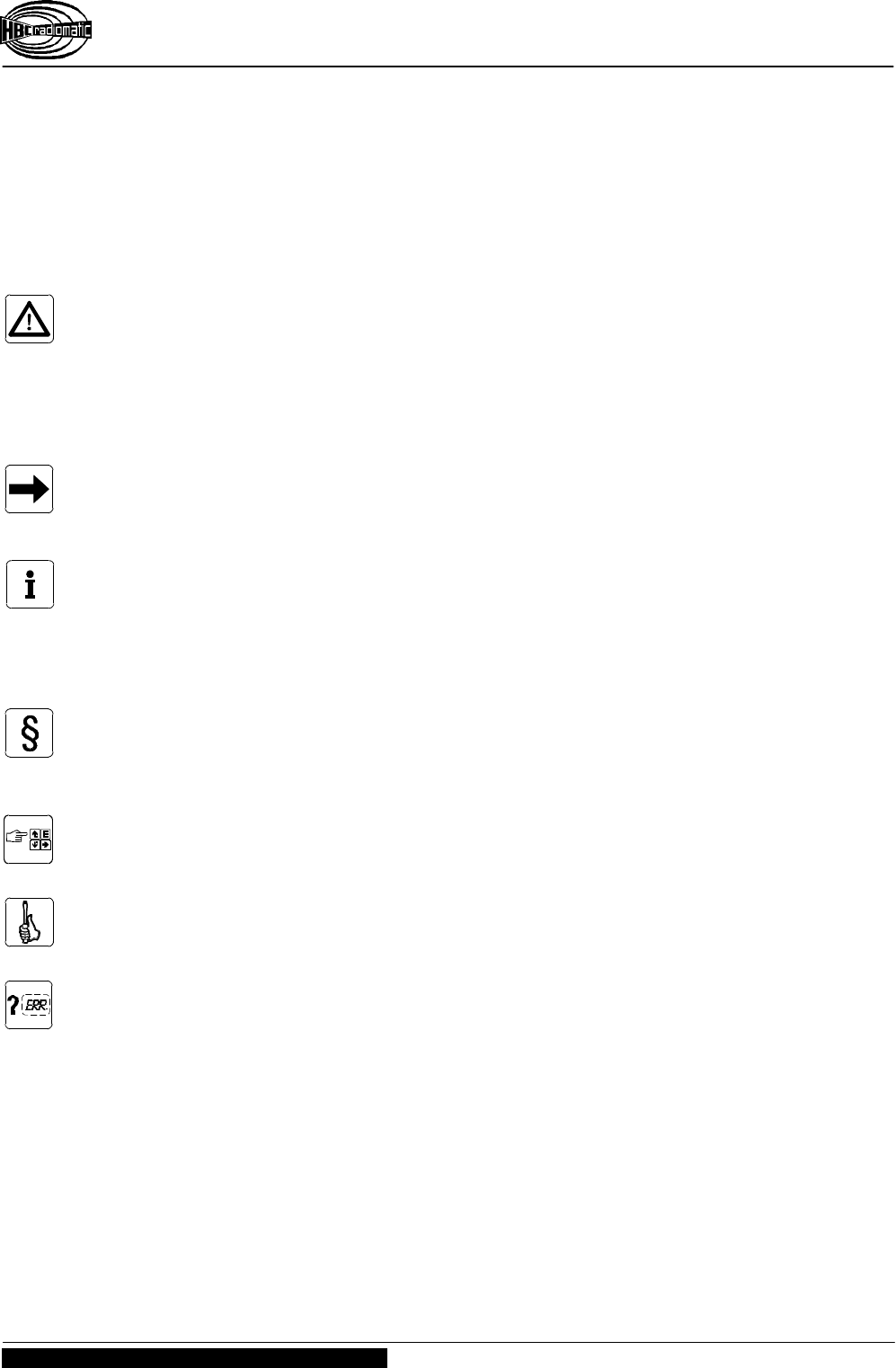
Operating Instructions
Radio Transmitter patrol ( Industrial Version )
Page 4 / 14 BE-PATROL-I-V2-1.DOC [ Word 97 ] FL
HBC-radiomatic GmbH • D-74564 Crailsheim • GERMANY
04-25-2000 All rights reserved through HBC-radiomatic GmbH. Technical changes made without notice.
Radio Control System
1Helpful Hints
Following symbols are used in the operating instructions at hand:
Warnings
This symbol will show situations that could be dangerous for people or machines.
Pay particular attention in reading the parts of this manual.
Be careful and try to avoid these situations.
Notes
This symbol will show important operating hints to guarantee a long working life
to the apparatus.
Do not forget to observe these notes. The radio control could become unreliable.
This symbol will show general information.
Others
This symbol will show regulations, e.g. notes on local, regional and federal
regulations on labor safety and accident prevention when operating a radio
controlled system.
This symbol will identify the "Operation" section .
This symbol will give you helpful maintenance notes in the corresponding section.
This symbol will identify the trouble-shooting section.

Operating Instructions
Radio Transmitter patrol ( Industrial Version )
BE-PATROL-I-V2-1.DOC [ Word 97 ] FL Page 5 / 14
HBC-radiomatic GmbH • D-74564 Crailsheim • GERMANY
All rights reserved through HBC-radiomatic GmbH. Technical changes made without notice. 04-25-2000
Radio Control System
2Safety Regulations
Ø Strictly observe and always adhere to the respective regulations on labor safety and
accident prevention when operating a radio controlled system !
Ø Retrofitting of a radio control to a machine is considered to be a major modification.
The machine must therefore be subject to an approval inspection. The user of the
machine is responsible for a proper entry of this inspection in the machine’s
inspection record.
Ø The commissioning of the radio equipment is only possible if you dispose of a
special authorization from the postal authorities.
Ø Before using the radio control, it is necessary to be familiarized with this system !
Therefore, only authorized and sufficiently instructed personnel who are familiar with
the instructions should be allowed to use the radio control.
Ø In case of a defect, an emergency situation and whenever a malfunction occurs in
the working area of the radio system, it is required that it be switched OFF
immediately until the cause of the defect has been located and repaired !
– Switch OFF the transmitter via the EMERGENCY-STOP pushbutton.
– Disconnect the connecting cable from the receiver.
Ø Have defective radio systems repaired only by an expert. Use only original
replacement parts of the manufacturer for any repair.
2.1 Warning Notes
Ø The crane operator is required to control the machine in such a way that no danger
may possibly occur, even if the radio transmission is interrupted.
Ø The remote control transmitter may be switched ON only as long as a visual contact
exists with the crane.
Ø The minimum duration of the command and the response time are slightly increased
by the radio control (cf. specifications of the radio control system).
Ø The radio control transmitter may only be connected to machines suitable for the
installation of a radio control system via the appropriate cable connections.

Operating Instructions
Radio Transmitter patrol ( Industrial Version )
Page 6 / 14 BE-PATROL-I-V2-1.DOC [ Word 97 ] FL
HBC-radiomatic GmbH • D-74564 Crailsheim • GERMANY
04-25-2000 All rights reserved through HBC-radiomatic GmbH. Technical changes made without notice.
Radio Control System
2.2 Safety Notes Regarding Operation
Ø Before using the radio control system for the first time, read these operating
instructions completely and carefully.
Ø In case of a defect, an emergency situation and whenever a malfunction occurs in
the working area of the radio system, it is required to de-energize the radio
equipment immediately until the cause of the fault has been located and repaired !
– Switch OFF the transmitter via the EMERGENCY-STOP pushbutton.
– Disconnect the connecting cable from the receiver.
Ø During breaks and at the end of work, disconnect the transmitter by means of the
"ON / OFF" toggle switch.
Ø Usage of radio remote control systems outside of manufacturer’s guidelines (section
3) may result in invalidity of the guarantee.
2.3 Safety Notes when Operating the Transmitter
Ø Before you start working, always verify the operation of the EMERGENCY-STOP
pushbutton.
Ø It is not allowed to leave a connected transmitter and not supervise it.
Ø In case of an emergency and in case of all sorts of problems in the working range of
the machinery or in case of a technical failure of the radio control, you must stop the
crane or machine by pressing the EMERGENCY-STOP pushbutton !
Ø During breaks and at the end of work, disconnect the transmitter by means of the
"ON / OFF" toggle switch.
Ø The operation of the transmitter is permissible only with the carrying set included
with the transmitter (possibility of mixing up the controls) !
2.3.1 Safety Notes Regarding Battery and Battery Charger
Ø Operate the battery charger at about room temperature and protect it against
overheating (e.g. direct sun radiation).
Ø Quick charging of NiCd batteries only in a temperature range between +10 °C and
+40 °C (50 °F and 104 °F).
Ø Protect the battery contacts against accidental shortening, i.e. do not store the
batteries in a tool box or carry them loosely in your pockets. A bunch of keys is
enough to shorten the battery. Use the protective caps delivered with the batteries.
Ø Pay attention to correct polarity ! – After inserting the battery into the battery
compartment of the battery charger, the nameplate must be visible. Operation of the
transmitter will not be possible otherwise !
Ø The NiCd batteries are charged in the factory. Due to longer storage times, however,
the batteries may reach you partially charged or discharged. Therefore, they should
be charged before the first use. To charge the battery, remove it from the transmitter
and put it into the battery compartment of the battery charger.

Operating Instructions
Radio Transmitter patrol ( Industrial Version )
BE-PATROL-I-V2-1.DOC [ Word 97 ] FL Page 7 / 14
HBC-radiomatic GmbH • D-74564 Crailsheim • GERMANY
All rights reserved through HBC-radiomatic GmbH. Technical changes made without notice. 04-25-2000
Radio Control System
2.4 Safety Notes Regarding Maintenance
Ø Pay attention to smaller deficiencies. They are often the symptoms of a major defect
and may result in severe malfunctions of the radio system.
Ø Have defective radio systems repaired only by an expert. Use only original
replacement parts of the manufacturer for any repair.
2.5 Certificates, Certifications
This system made by HBC-radiomatic GmbH corresponds to the CE standards and has
an approval of the Federal Office for Homologations in the field of Telecommunications
(Federal Republic of Germany).
2.5.1 Nameplate
The nameplate indicates all important data of the radio equipment. Besides the service
voltage, radio frequency and the address of the system, this plate also indicates the
production number which is necessary in case of possible further inquiries or spare part
orders. It also contains the European control number for Homologation in the
Telecommunication.
Note :
Please make sure that the nameplate is always clearly visible to allow for a
verification by the authorities.

Operating Instructions
Radio Transmitter patrol ( Industrial Version )
Page 8 / 14 BE-PATROL-I-V2-1.DOC [ Word 97 ] FL
HBC-radiomatic GmbH • D-74564 Crailsheim • GERMANY
04-25-2000 All rights reserved through HBC-radiomatic GmbH. Technical changes made without notice.
Radio Control System
3Description of the System and Application
The system consists of a transmitter hosing with max. five toggle switches and two
pushbuttons (DJet), an EMERGENCY-STOP pushbutton, a battery charger with two
rechargeable NiCd batteries and a receiver with an antenna, a connecting cable and a
mating connector.
The industrial radio transmitter patrol enables – in combination with a corresponding
receiver – control of industrial working machines.
The transmitter housing is made of impact resistant plastic with a built-in antenna.
The system is equipped to control receivers with 6 to 12 operating commands and works
within a 70 cm frequency band (420 ... 470 MHz).
State of the art radio technology complying with the latest guidelines of the regulations
on labor safety and the use of highly developed microprocessor technology guarantees
optimal operating safety, availability and longevity.
Following radio receivers can be controlled by this transmitter type :
FSE 505 FSE 707 FSE 808 (industrial version)
3.1 Specification
General Technical Data
System patrol
Number of control commands max. 12
Unique system address over 65,000 possibilities
Transmitter-specific Technical Data
Transmitting power (FuS 671/3) < 10 mW (synthesizer)
Transmitting antenna integrated in the belt side piece
Battery type FuB 05 AA (orange)
Voltage supply via NiCd battery 6 V DC / 600 mAh
Duration of operation max. 8 h per battery charge
Operating temperature range –25 °C ... +75 °C (–13 °F ... +167 °F)
Hosing material impact resistant plastic
Housing color orange / black
Dimensions short version
long Version
116 x 58 x 105 mm (L x B x H)
4.6 x 2.3 x 4.1 " (L x W x D)
117 x 72 x 135 mm (L x B x H)
4.6 x 2.8 x 5.3 " (L x W x D)
Weight (approx.) 750 g (12.3 oz)
Protection class IP 55
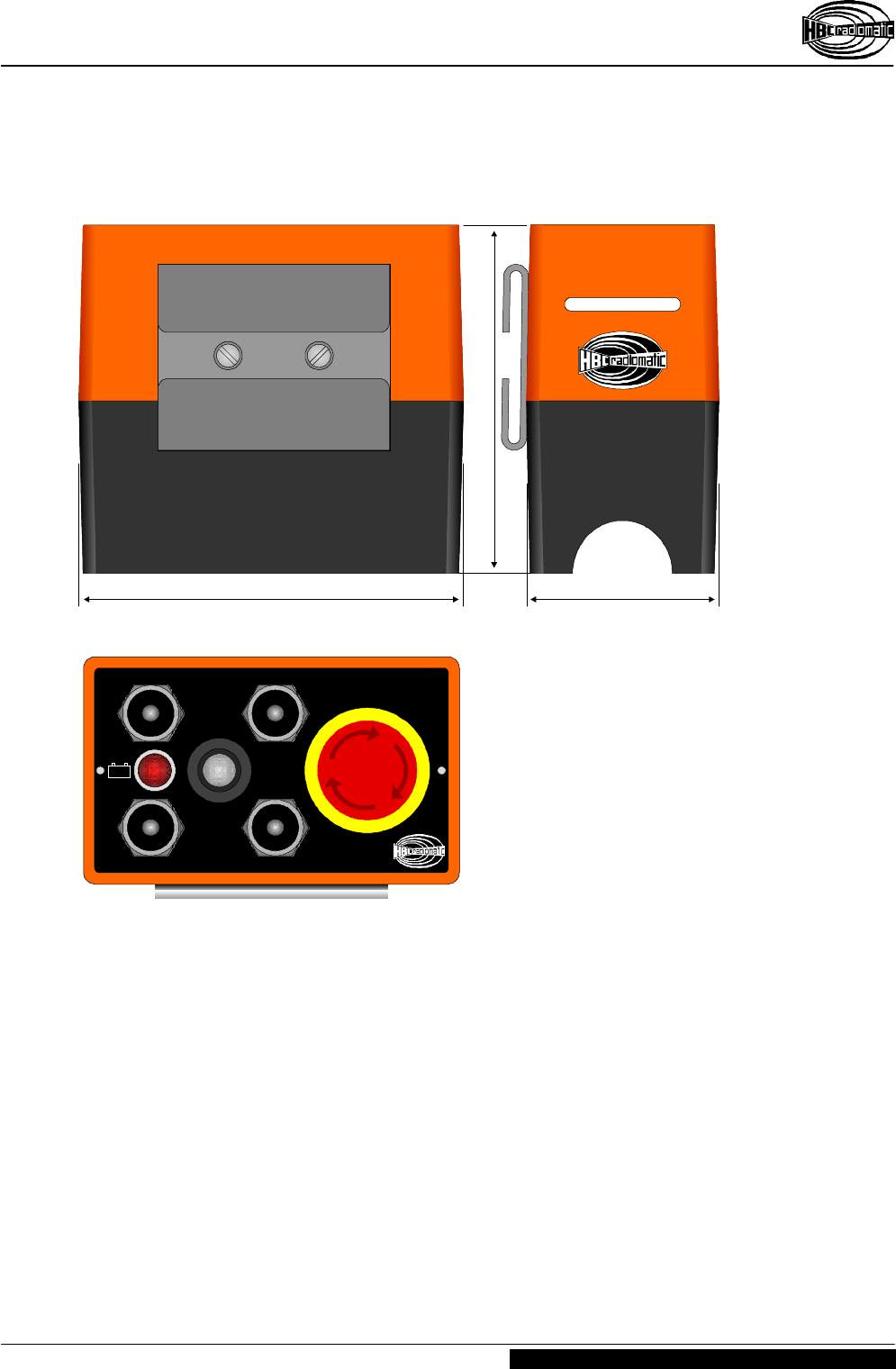
Operating Instructions
Radio Transmitter patrol ( Industrial Version )
BE-PATROL-I-V2-1.DOC [ Word 97 ] FL Page 9 / 14
HBC-radiomatic GmbH • D-74564 Crailsheim • GERMANY
All rights reserved through HBC-radiomatic GmbH. Technical changes made without notice. 04-25-2000
Radio Control System
3.1.1 Dimensions and Operating Elements of patrol
– Short Version
116 mm (4.6 ")
105 mm (4.1 ")
58 mm (2.3 ")
ON OFF
–+
À
Á
Ã
Ã
Ä
Å
Ä
Â
File: PATROL-I_K.CDR [ CorelDraw 6.0 ] 04-20-2000 FL
À
Á
Â
Ã
Ä
Å
Toggle switch Transmitter "ON / OFF"
red LED "Charge battery"
EMERGENCY-STOP pushbutton
Toggle switch or DJET key
Toggle switch
Belt side piece with integrated transmitter antenna
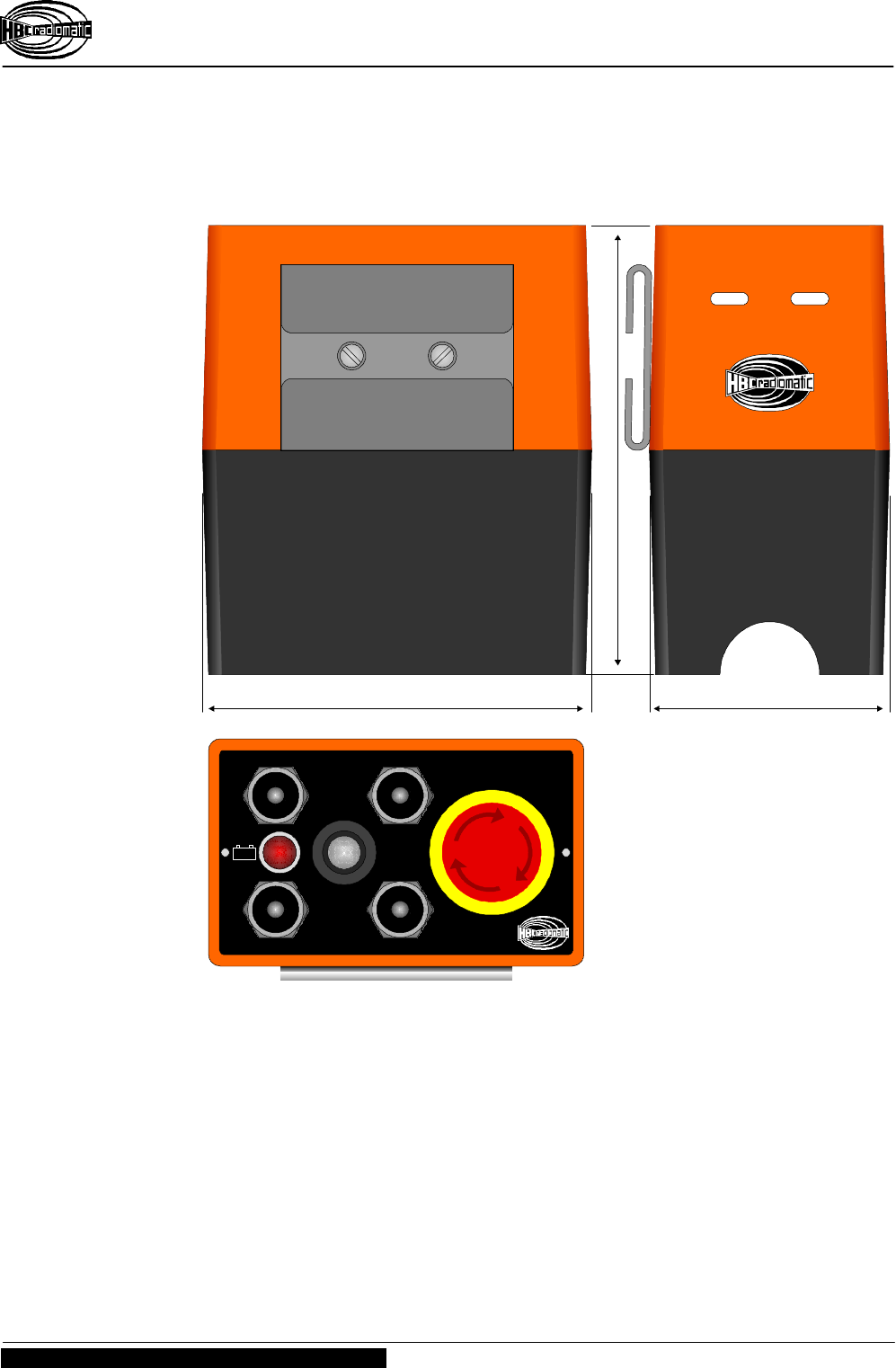
Operating Instructions
Radio Transmitter patrol ( Industrial Version )
Page 10 / 14 BE-PATROL-I-V2-1.DOC [ Word 97 ] FL
HBC-radiomatic GmbH • D-74564 Crailsheim • GERMANY
04-25-2000 All rights reserved through HBC-radiomatic GmbH. Technical changes made without notice.
Radio Control System
3.1.2 Dimensions and Operating Elements of patrol
– Long Version
117 mm (4.6 ")
135 mm (5.3 ")
72 mm (2.8 ")
File: PATROL-I_L.CDR [ CorelDraw 6.0 ] 20.04.2000 FL
ON OFF
–+
À
Á
Â
Ã
Ä
Å
Toggle switch Transmitter "ON / OFF"
red LED "Charge battery"
EMERGENCY-STOP pushbutton
Toggle switch or DJET key
Toggle switch
Belt side piece with integrated transmitter antenna
À
Á
Ã
Ã
Ä
Å
Ä
Â
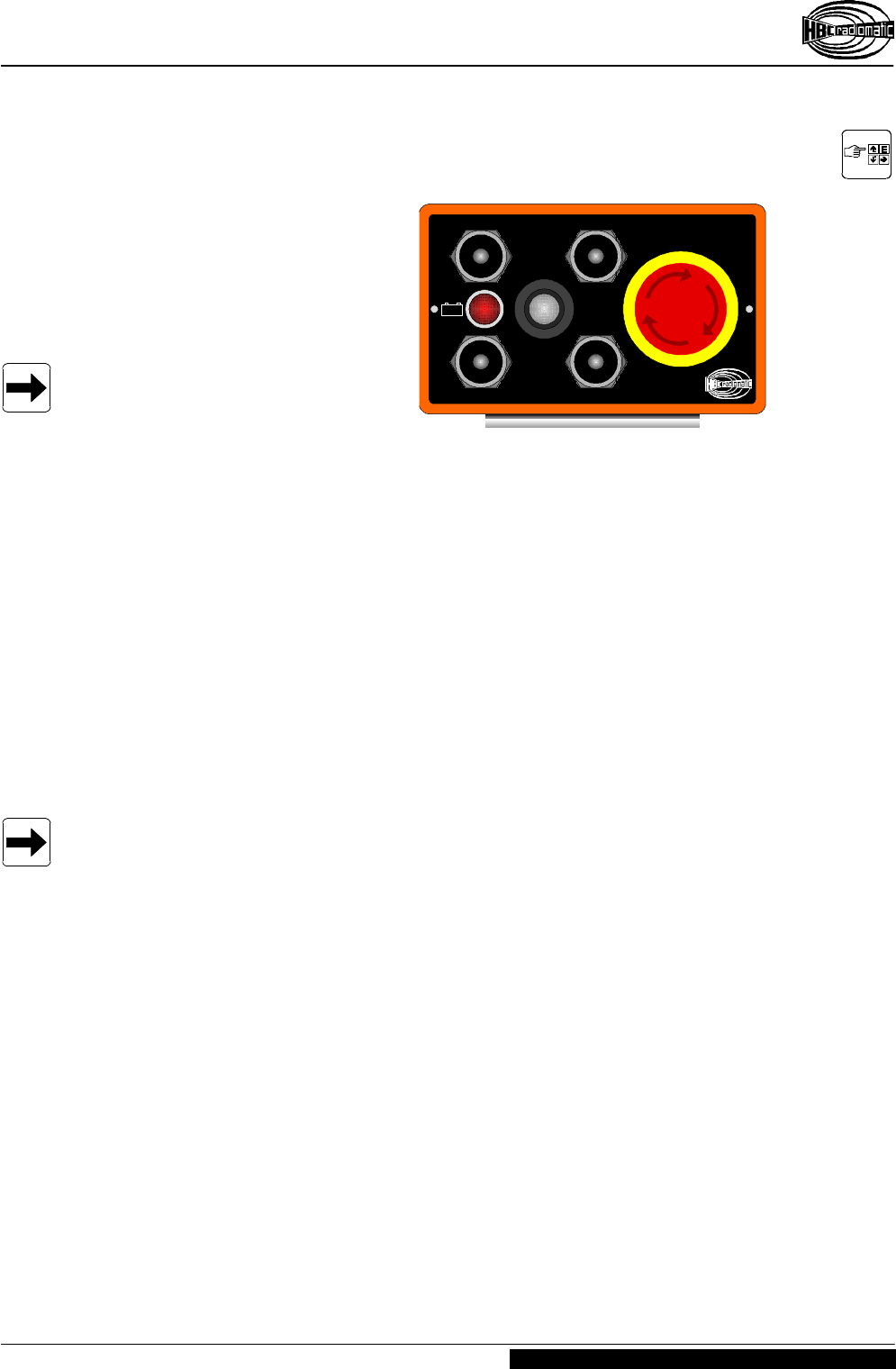
Operating Instructions
Radio Transmitter patrol ( Industrial Version )
BE-PATROL-I-V2-1.DOC [ Word 97 ] FL Page 11 / 14
HBC-radiomatic GmbH • D-74564 Crailsheim • GERMANY
All rights reserved through HBC-radiomatic GmbH. Technical changes made without notice. 04-25-2000
Radio Control System
4Operation
1. Prior to the first initial start-up or before
you start working, a charged FuB 05 AA
battery must be inserted into the battery
compartment on the underside of the
transmitter. The battery supplies the
voltage required for the operation of the
transmitter (6 V DC).
Note :
After inserting the battery, the
nameplate must be visible. Operation
of the transmitter will not be possible
otherwise !
2. Unlock the EMERGENCY-STOP pushbutton (item Â) by turning it.
3. Switch ON the transmitter via the "ON / OFF" toggle switch (item À ; pay attention to
marking !).
Operating voltage is now present at the transmitter.
A radio connection to the receiver is established when the red LED "NO RECEPTION"
on the receiver will be extinguished and the green LED "SYSTEM" is illuminated (ref.
radio status panel of the receiver), i.e. the radio system is ready to operate.
Control commands may now be input via the transmitter.
If the red LED on the transmitter (item Á) flashes, this indicates that the battery is
almost fully discharged. Now, you must replace the discharged battery by a charged one
and recharge the discharged battery (cf. "Battery Charger").
Note :
If the discharged battery is not replaced by a charged one, the transmitter will
automatically be switched OFF after a few minutes.
ON OFF
–+
À
Á
Â
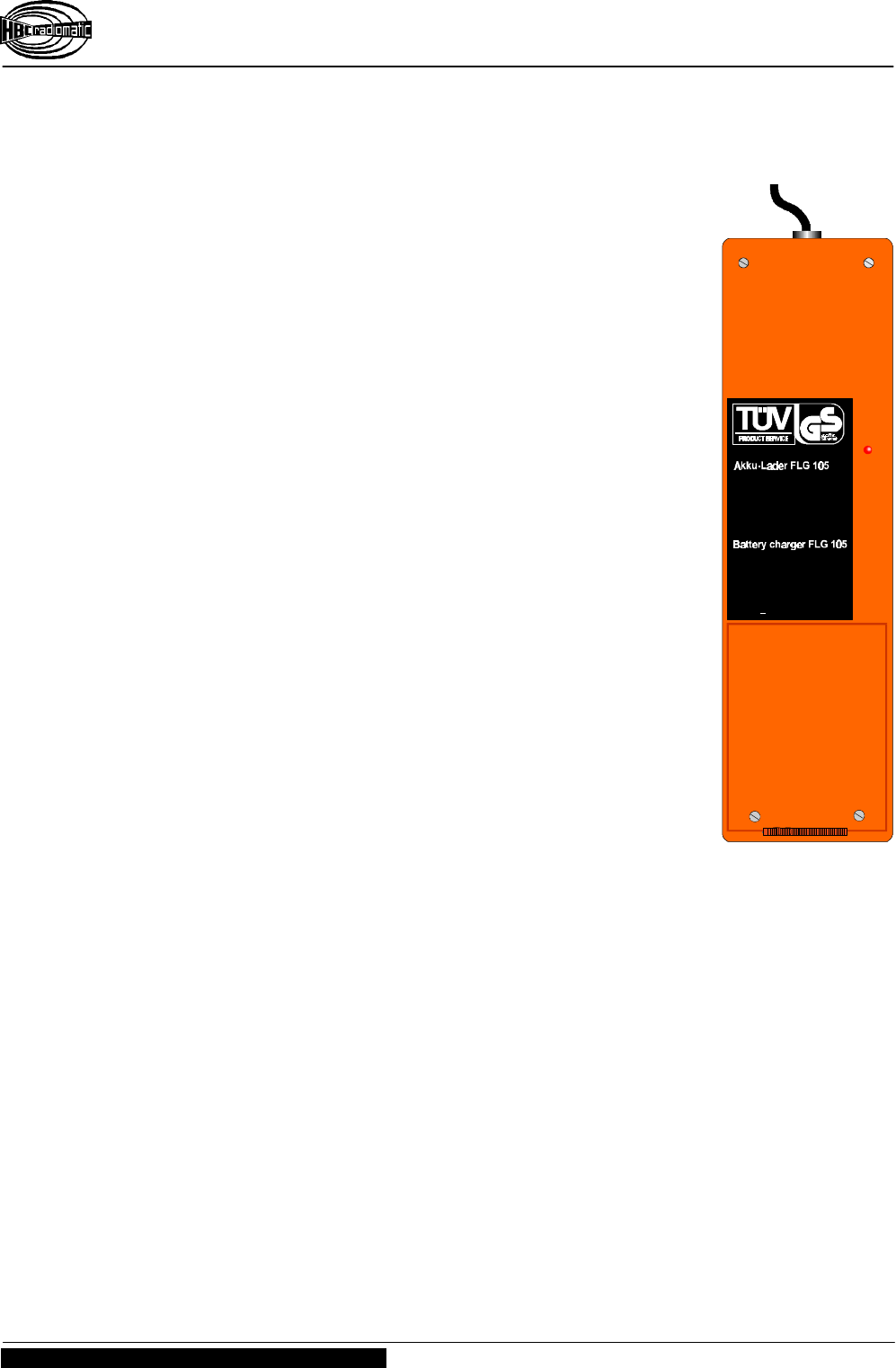
Operating Instructions
Radio Transmitter patrol ( Industrial Version )
Page 12 / 14 BE-PATROL-I-V2-1.DOC [ Word 97 ] FL
HBC-radiomatic GmbH • D-74564 Crailsheim • GERMANY
04-25-2000 All rights reserved through HBC-radiomatic GmbH. Technical changes made without notice.
Radio Control System
4.1 Battery Charger
Fig. left shows battery charger type FLG 105 that is suitable for one each of the
battery types FuB 05 AA or FuB 3A (with adapter).
Charge Battery
1. Connect the net cable of the battery charger to the mains (cf.
nameplate of the battery charger).
2. Insert the battery into the battery compartment (item Á) (the
nameplate of the battery must be visible from outside).
=> The red LED (item À) is illuminated.
Display of the state of charge (red LED)
LED illuminated : ......................... The battery is being charged.
LED off or flashing : ..................... The battery is charged,
i.e. ready for operation.
LED flashes when
inserting the battery : ................... The Battery is exhausted
or defective.
Remarks :
– A discharged FuB 05 AA battery is fully charged after about 4 or 5 hours.
Overcharging of the battery is prevented by the integrated electronic that will limit
the charging process to a maximum of 5 hours.
– Quick charging of NiCd batteries only in a temperature range between +10 C and
+40 C (50 °F and 104 °F).
– Protect the battery contacts against accidental shortening, i.e. do not store the
batteries in a tool box or carry them loosely in your pockets. A bunch of keys is
enough to shorten the battery. Use the protective caps delivered with the batteries.
– Operate the charging unit at about room temperature and protect it against
overheating (e.g. direct sun radiation).
++
LadungnurbeiZimmertemperatur!
Akkueinlegen.
Dauerlicht:Akkuwirdgeladen.
Blinken:Akkuentnehmen.
Betriebsanleitung beachten!
For roomtemperatureonly!
Insertbattery.
Steadylight:Charging.
Blinkinglight:Removebattery.
!See operating instructions
Á
À

Operating Instructions
Radio Transmitter patrol ( Industrial Version )
BE-PATROL-I-V2-1.DOC [ Word 97 ] FL Page 13 / 14
HBC-radiomatic GmbH • D-74564 Crailsheim • GERMANY
All rights reserved through HBC-radiomatic GmbH. Technical changes made without notice. 04-25-2000
Radio Control System
5Maintenance
The radio system is largely maintenance-free. The following items should nevertheless be taken
into account :
Ø Make sure that the EMERGENCY-STOP pushbutton as well as all other keys and
switches move easily.
Dirt of any kind may interfere with the operation of the pushbuttons or switches or
even render it impossible.
Ø The batteries of the transmitter should be completely discharged and charged again
on a regular basis.
Ø Never "clean" the transmitter with a pressure or with a steam cleaner.
If necessary, clean it with a fine brush or soft cloth, please
Note :
Should any problems occur with the radio system contact your local dealer or the
manufacturer.
5.1 In Case of a Defect
Caution :
It is not permissible to use a defective radio system !
Ø Never try to carry out any repair on the electronic components of the radio system.
This would result in a rejection of possible warranty claims.
− It is recommended to have the unit sent to the manufacturer as fast as possible.
The unit will then be in the hands of an expert, an expert who is familiar with the
system and who has the required special replacement parts at his disposal.
− Always send in the transmitter and receiver together and enclose a detailed
description of the defect.
− Do not forget to state your phone number in addition to your address. This will
allow us to contact you directly, should we have any inquiries.
Ø In order to prevent any transport damages from occurring, please use the
specifically molded two-way packaging in which the unit was shipped to you from the
factory or pack the unit in a way so that it is protected against shocks. Please send
the unit to the following address, freight prepaid :
HBC-radiomatic GmbH
Haller Straße 49 - 53 • D-74564 Crailsheim
Ø Should you decide to personally return a defective radio system to the factory or to
your local dealer, then please make an appointment first.

Operating Instructions
Radio Transmitter patrol ( Industrial Version )
Page 14 / 14 BE-PATROL-I-V2-1.DOC [ Word 97 ] FL
HBC-radiomatic GmbH • D-74564 Crailsheim • GERMANY
04-25-2000 All rights reserved through HBC-radiomatic GmbH. Technical changes made without notice.
Radio Control System
6Trouble-Shooting
Note :
Check the transmitter functions with the cabin or the cable control unit first !
Trouble Possible Cause Remedy
No reaction whenever the
transmitter is switched ON. − There is no operating
voltage present.
− The transmitter is not
switched ON.
− The EMERGENCY-STOP
pushbutton is locked.
− Charge the battery or
insert a fully charged
battery into the
transmitter.
− Check the battery
contacts for damage or
contamination.
− Switch the transmitter
ON.
− Unlock the EMERGENCY-
STOP pushbutton.
Low battery voltage
warning output already
after a short period of
operation, i.e. the red
transmitter LED flashes.
− The battery is not
charged.
− The battery is defective.
− Charge the battery fully.
− Check if the charging
process is executed
properly.
− Check the battery
contacts.
− Verify the operation with
a functional battery.